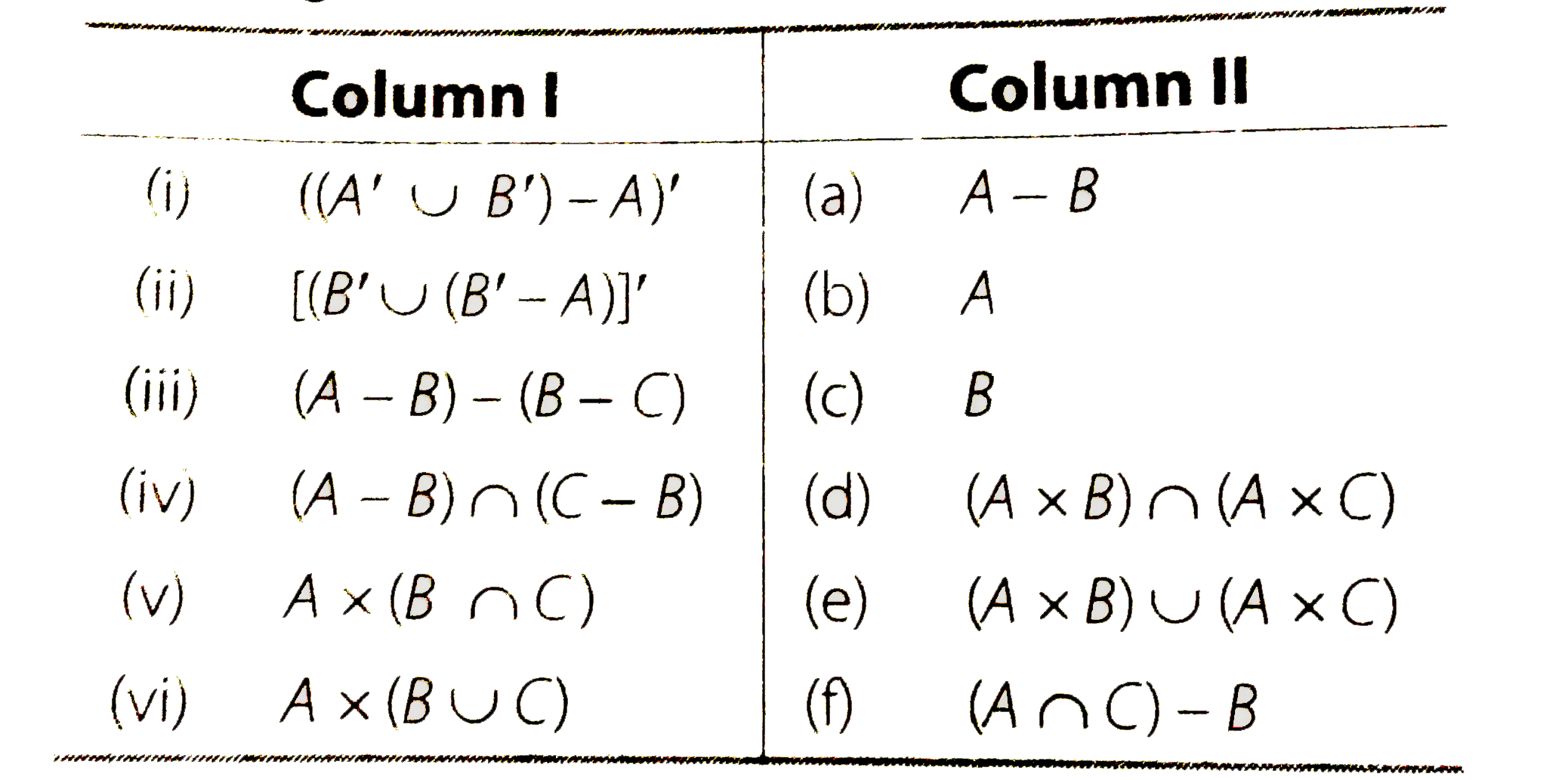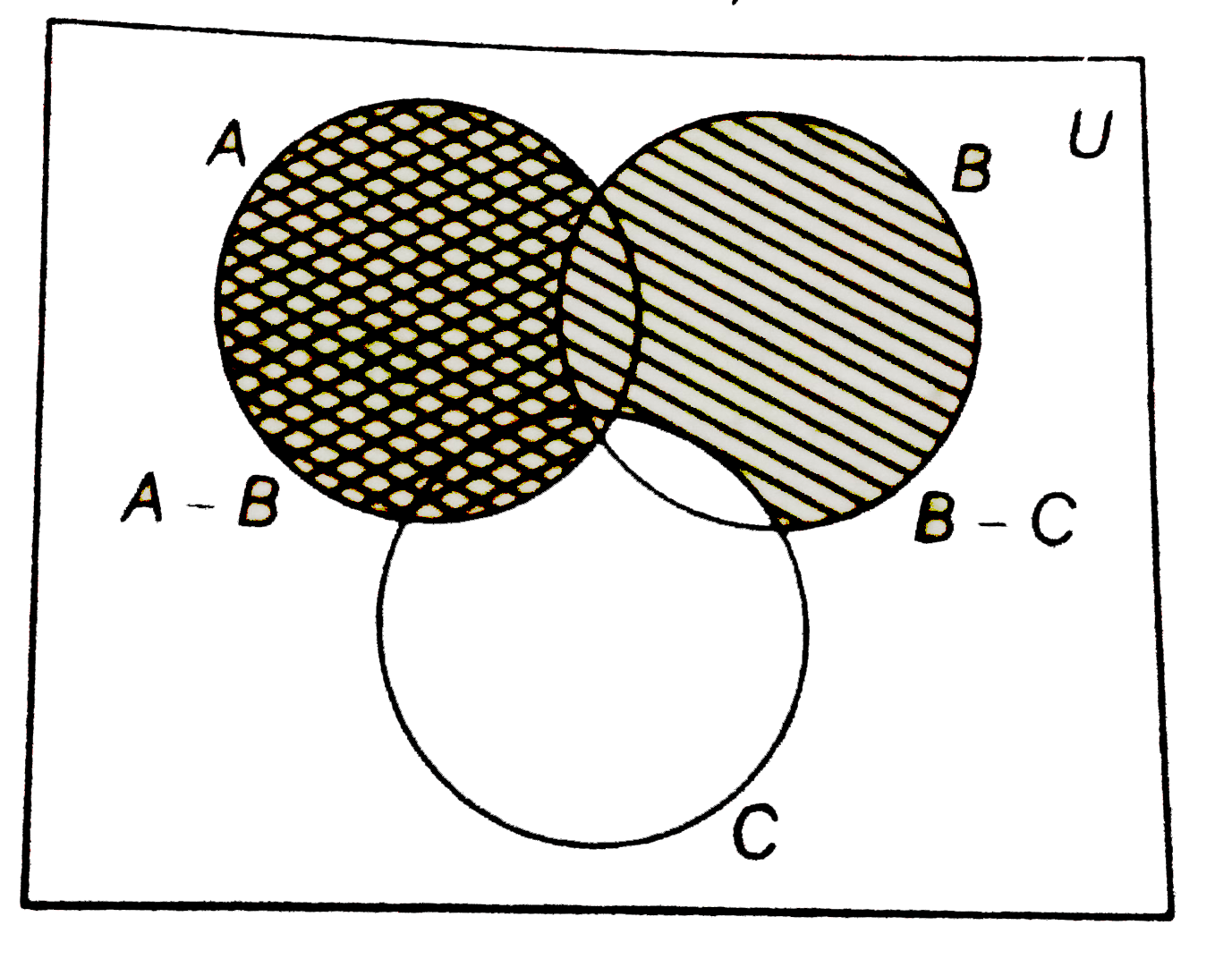Match the following sets for all sets A, B and C

(i) [(A'∪B')−A]'=[(A'∪B')∩A']',[∵A−B=A∩B']
=[(A∩B)'∩A']',[∵(A∩B)'=A'∪B']
=[(A∩B)']'∪(A')'=(A∩B)∪A,[∵(A')'=A]
=A
(ii) [B'∪(B'−A)]'=[B'∪(B'∩A')]',[∵A−B=A∩B']
=[B'∪(B∪A)']',[∵A'∩B'=(A∪B)']
=(B')'∩[(B∪A)']',[∵(A∪B)'=A'∩B']
=B∩(B∪A),[∵(A')'=A]
=B
(iii) (A−B)−(B−C)=(A∩B')−(B∩C')
=(A∩B')∩(B∩C')',[∵A−B=A∩B']
=(A∩B')∩[B'∪(C')']
=(A∩B')∩(B'∪C),[∵(A')'=A]
=[A∩(B'∪C)]∩[B'∩(B'∪C)]
=[A∩(B'∪C)]∩B'
=(A∩B')∩[(B'∪C)∩B']
=(A∩B')∩B'=A∩B'=A−B
Alternate Method
It is clear from the diagram, (A−B)−(B−c)=A−B

(iv) (A−B)∩(C−B)
⇒(A∩B')∩(C∩B'),[∵A−B=A∩B']
⇒(A∩C)∩B'
⇒(A∩C)−B,[∵A∩B'=A−B]
(v) A×B∩C=(A×B)∩(A×C)
(vi) A×(B∪C)=(A×B)∪(A×C)
Hence , the correct maches are
(i)↔(b),(ii)↔(c),(iii)↔(a),(iv)↔(f),(v)↔(d),(vi)↔(e)
Topper's Solved these Questions
- SETSBOOK - NCERT EXEMPLAR ENGLISHCHAPTER - SETSEXERCISE - TRUE AND FALSE
6 Videos
- SETSBOOK - NCERT EXEMPLAR ENGLISHCHAPTER - SETSEXERCISE - OBJECTIVE TYPE QUESTIONS
14 Videos
- SEQUENCE AND SERIESBOOK - NCERT EXEMPLAR ENGLISHCHAPTER - SEQUENCE AND SERIESEXERCISE - Match the comumms
2 Videos
- STATISTICSBOOK - NCERT EXEMPLAR ENGLISHCHAPTER - STATISTICSEXERCISE - FILLERS
7 Videos
Similar Questions
Knowledge Check
Given the sets A={1,3,5}, B={2,4,6} and C={0,2,4,6,8}. Then, which of the following may be considered as universal set for all the three sets A, B and C ?
A{0,1,2,3,4,5,6}BϕC{0,1,2,3,4,5,6,7,8,9,10}D{1,2,3,4,5,6,7,8}Given sets A={1,3,5,7,9},B={0,2,4,6} and C={7,8,9}. Which of the following may be taken as universal set for all the three sets A,B and C?
AA. {0,1,2,3,4,5,6,7,8}BB. {1,2,3,4,5,6,7,8,9}CC. {1,2,3,4,5,6,7,8,9,10}DD. {0,1,2,3,4,5,6,7,8,9,10}A is set of the factors of 28, b is a set of the factors of 17 and C is a set of the odd multiples of 7 less than 50. Which of the following are singleton sets ?
(A) A∩B (ii) C∩B
(C) A∩CAOnly (A) and (B)BOnly (B) and (C)COnly (A) and (C)D(A), (B) and (C)
Write the following sets in set builder form :
B = {all months of a year}
View SolutionConsider the following sets:
A = set all rectangles in the same plane
B = set all squares in the same plane
C = set all parellegrams in the same plane
Find the following sets : (i)A−B(ii)C−A(iii)A∩C(iv)B∩C(v)B∪C(Vi)A∩B∪C
View SolutionConsider the following sets:
A = set all rectangles in the same plane
B = set all squares in the same plane
C = set all parellegrams in the same plane
Find the following sets : (i)A−B(ii)C−A(iii)A∩C(iv)B∩C(v)B∪C(Vi)A∩B∪C
View SolutionA is a set of all the prime numbers less than 20, B is a set of all the even natural numbers less than 20 and C is a set of all the odd natural numbers. Which of the following is/are true statements ?
(A) A∩B is a singleton set.
(B) B and C are disjoint sets.
(C) A∩C is an infinite set.
View SolutionWrite the following sets in the roster form B= set of all prime numbers between 50 and 70
View Solution
